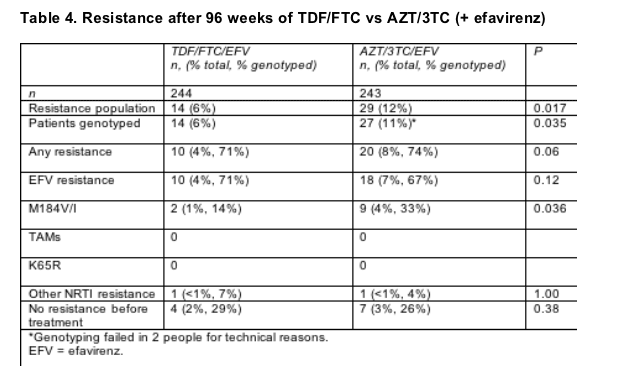 |
 |
 |
| |
Resistance analysis of TDF/FTC-versus-AZT/3TC trial
|
| |
| |
Excerpted from Resistance Before Therapy, Hidden Mutations, and Blips
46th ICAAC, September 27-30, 2006, San Francisco
Mark Mascolini
Resistance analysis of TDF/FTC-versus-AZT/3TC trial
After 96 weeks of follow-up in Gilead study 934, significantly more previously untreated people taking tenofovir/emtricitabine (TDF/FTC) than Combivir (AZT/3TC)--both with efavirenz--met the primary endpoint of a viral load below 400 copies in a time-to-loss-of-virologic-response analysis (75% versus 62%, P = 0.004) [15]. The better virologic response with TDF/FTC meant that significantly fewer people in that group met study criteria for resistance testing, and significantly fewer ended up with the M184V or M184I mutation, which evolves with failure of FTC or 3TC (Table 4) [16].

Failure of TDF/FTC/efavirenz evoked resistance to efavirenz at the same rate as failure of AZT/3TC/efavirenz did (71% versus 74%). M184V or M184I evolved less often than efavirenz-related mutations in both groups, but mutations at 184 arose more than twice as often upon failure of AZT/3TC than upon failure of TDF/FTC (33% versus 14%).
To learn more about the relative impact of FTC or 3TC on evolution of resistant virus, the Gilead team compared resistance rates among people taking TDF/FTC/efavirenz in this trial and treatment-naive people starting TDF/3TC/efavirenz in an earlier study [17]. Through 96 weeks of follow-up, significantly more people taking TDF/3TC than TDF/FTC required resistance testing (about 10% versus 5%, P = 0.018). Differences between those groups in proportions with resistant virus upon genotyping approached statistical significance (about 7% for TDF/3TC versus 4% for TDF/FTC, P = 0.061).
Among the 14 people with resistance mutations upon failure of TDF/FTC/tenofovir in the later trial [16], 1 had virus with decreased susceptibility to FTC and 3TC but not to NNRTIs, 1 had decreased susceptibility to FTC and 3TC and to efavirenz and nevirapine, and 6 had decreased susceptibility to efavirenz and/or nevirapine but not to NRTIs. This study also yielded evidence that people with HIV-1 subtypes other than subtype B respond to TDF/FTC/efavirenz as well as people with subtype B.
References
15. Gallant J, Pozniak A, DeJesus E, et al. Efficacy and safety of tenofovir DF, emtricitabine and efavirenz (EFV) compared to fixed dose zidovudine/lamivudine and EFV through 96 weeks in antiretroviral treatment-naive patients. XVI International AIDS Conference. August 13-18, 2006. Toronto. Abstract TUPE0064.
16. McColl DJ, Margot N, Chuang S, et al. Study 934: lower rates of resistance development associated with tenofovir DF and emtricitabine plus efavirenz at week 96. 46th ICAAC. September 27-30, 2006. San Francisco. Abstract H-1004.
17. Gallant JE, Staszewski S, Pozniak AL, et al. Efficacy and safety of tenofovir DF vs stavudine in combination therapy in antiretroviral-naive patients: a 3-year randomized trial. JAMA 2004;292:191-201.
|
| |
|
 |
 |
|
|